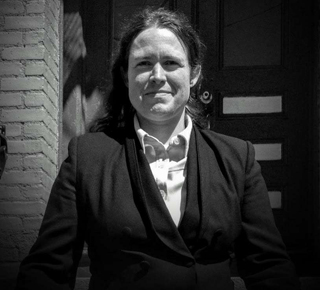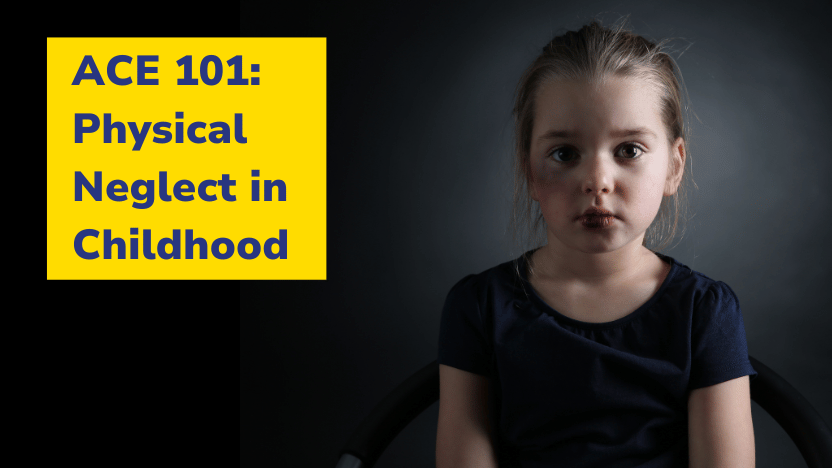Physical neglect is an ACE (Adverse Childhood Experience) that we hear a lot about but can be tricky to understand. It can also mean slightly different things in different contexts when we discuss child protection. So let’s unpack what physical neglect in childhood is, what it isn’t, and how to protect children from this ACE.
What is physical neglect in childhood?
The ACE study defines physical neglect in childhood as “Before your 18th birthday, did you often or very often feel that you didn’t have enough to eat, had to wear dirty clothes, and had no one to protect you? Or your parents were too drunk or high to take care of you or take you to the doctor if you needed it?”
This definition of physical neglect in childhood, like all definitions used in the ACE study, attempts to capture what physical neglect feels like to a child rather than capture physical details of the child’s home. It also focuses on a pattern of behaviors rather than a single event; while unpleasant, if a child has to skip a meal or wear dirty clothes to school on occasion, those infrequent events don’t rise to the level of a life-altering trauma.
Child Protective Services in different states will sometimes amend this definition, so if you’re reading about child abuse as defined by local laws, “physical neglect” may include things like:
- Improper supervision,
- Exposing a child to domestic violence or substance abuse, or
- Even failure to ensure that a child regularly attends school.
Is physical neglect in childhood dangerous?
Yes. All ACEs can have equally bad long-term effects on emotional, social, physical, and financial health.
Additionally, physical neglect can kill a child in the short term and is associated with child abuse fatalities (most of the time, a child who dies from abuse or neglect will show evidence of both, which can make it difficult to determine precisely how the child died).
Examples of how a child may die of physical neglect include:
- An infant dying from dehydration because they weren’t fed for a period of time,
- An unsupervised toddler falling out a window to their death, or
- A small child ingesting fentanyl because they weren’t being supervised and someone in the household was using it.
Is physical neglect in childhood caused by poverty?
The short answer is “no,” but this is also why definitions are important. The original ACE study, conducted in a wealthy suburb of San Diego and only included people with high-end health insurance, documented that 10% of participants had survived physical neglect in childhood. While it is possible that some of those participants moved into a higher socio-economic bracket as adults, many of the participants likely experienced physical neglect in an upper-middle-class childhood.
Disentangling neglect from poverty
Child Protective Services sometimes struggle to disentangle neglect from poverty. While the ACE definition of physical neglect revolves around the frequency of the child being without something crucial, CPS is supposed to look at the parent’s utilization of resources in the community. If a parent is unable to connect with community resources, or has resources, but the child is still being denied essentials, there is something else going on with the parent. The possibilities include mental illness, failure to bond with the child, and other issues.
It is also important to realize that many impoverished families will not neglect their children. They manage to defy odds, utilize every resource at their disposal, and build a sense of safety for their children. Most parents want to do the right thing for their children even when their circumstances make that difficult.
It is also important to realize that a parent’s own ACE test score can predispose them to poverty, as well as to a host of other things that will make parenting difficult. So, while it’s true that we identify physical neglect in childhood more often in lower-income communities (and it probably happens more in lower-income communities), it can, and does, happen everywhere.
How do we prevent physical neglect in childhood?
An important first step to prevent physical neglect in childhood is to recognize that it happens everywhere.
Good secondary steps are to ensure that all parents (indeed, all people) have access to safe housing, food, and other essentials.
We need to stop judging parents, as individuals and institutionally. Rather than stigmatize parents making mistakes or not providing properly for their children, we need to recognize that all children deserve good parents and childhoods without ACEs. We need to recognize that physical neglect in childhood isn’t caused exclusively by poverty or bad parenting. Instead, we need to search for more comprehensive solutions.
Maternal Home Visiting programs help prevent physical neglect
Maternal Home Visiting programs are a good, evidence-based tool to prevent physical neglect and other ACEs.
A home visitor will be able to:
- Thoroughly understand the details of why the parent is neglecting their children,
- Connect them with community resources, if that’s the root of the problem,
- Teach them about healthier parenting techniques,
- Support the parent and model healthy relationships,
- Reduce parental stress, and
- Help the parent heal from their own trauma.
Heavy investment in Maternal Home Visiting programs is the best thing we can do to prevent physical neglect in childhood and other ACEs.
Additional resources for help
Childhelp National Child Abuse Hotline – (1-800-422-4453)
Child Welfare Information Gateway
You can help make sure this never happens to another child. Learn how by subscribing to our newsletter and supporting our work. Read about the ten categories of ACEs by following our blog. Do you know your ACE score? Take the ACE test here.
Do you know your score?
Discover your ACE score and unlock a new understanding of your life. Take the test and gain insights into how your early experiences shape your well-being. Don't let your past define you – empower yourself with knowledge.

Melanie Blow
Executive Director, Stop Abuse Campaign
A survivor of incest, psychological abuse and a host of other childhood trauma, Melanie now uses her talents to prevent Adverse Childhood Experiences. Melanie has over a decade of legislative advocacy regarding children’s issues, and she has been published in newspapers, magazines and blogs all across the country.
Melanie has an ACE score of 6.
